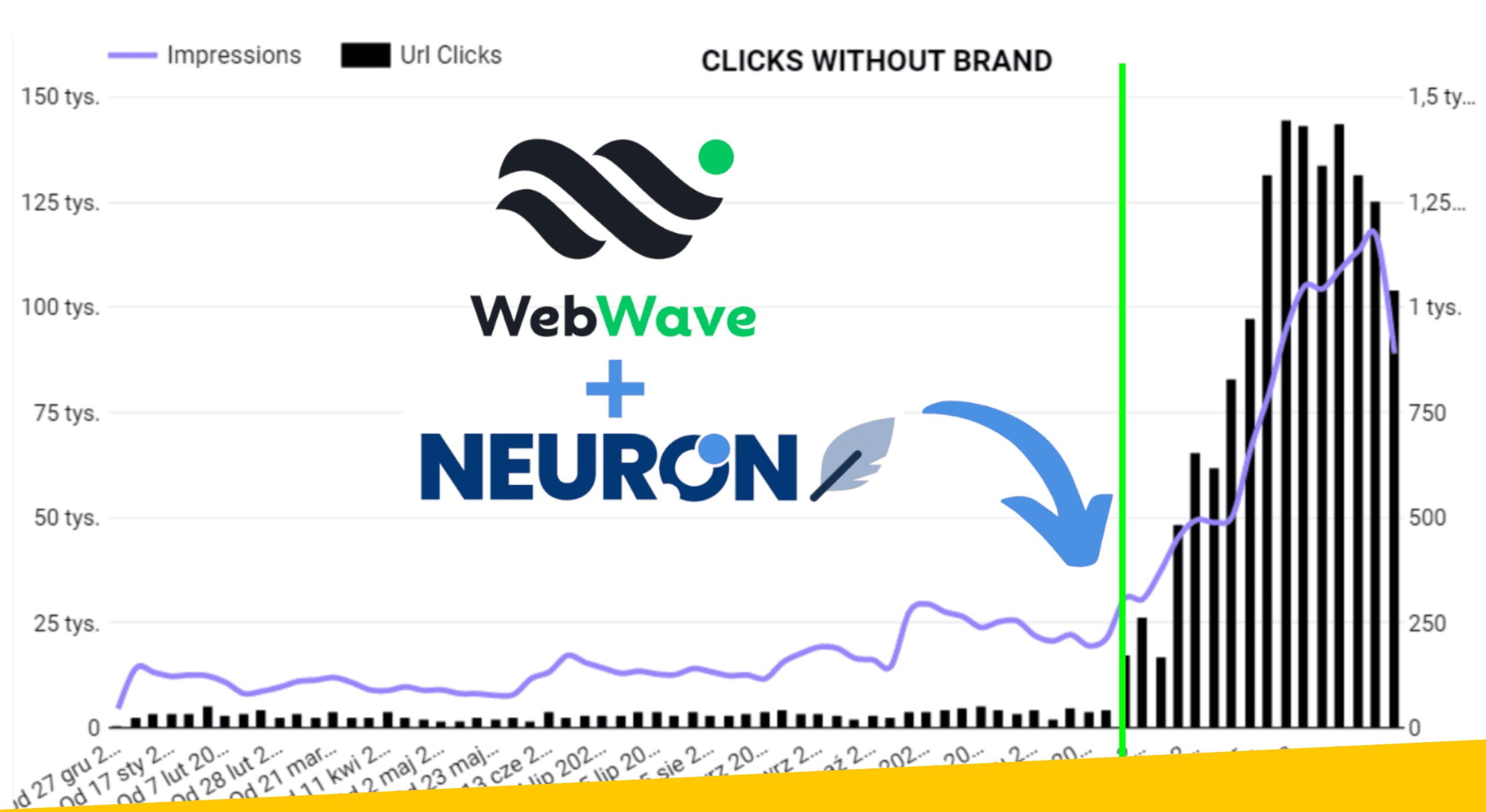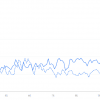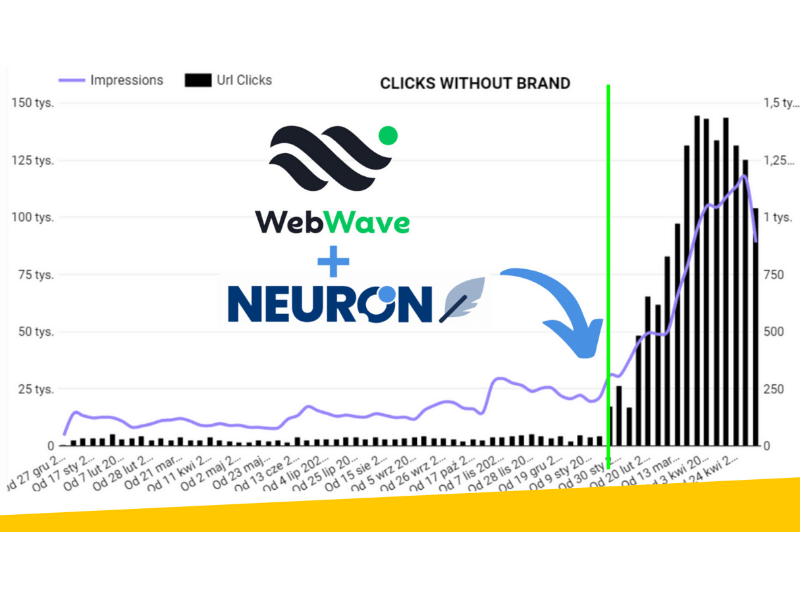





About WebWave and SEO challenge
WebWave is a website builder that allows users to create and customize their websites without coding. WebWave has a marketing team that was looking for a solution to boost content planning and writing. They wanted to increase their organic traffic and reach more potential customers.
They decided to use NEURONwriter, a content intelligence platform that helps content creators plan, write, optimize, and measure their content performance. Neuron uses artificial intelligence and natural language processing to analyze the web and provide data-driven insights and recommendations for content creation and optimization.
The WebWave website was created in WebWave. The platform is designed to optimize the site for SEO activities.
With NEURONwriter, WebWave was able to create high-quality and relevant content for its online presence that showcased its value proposition, features, benefits, and customer stories. WebWave also used NEURONwriter to optimize its existing content for SEO, by adding meta tags, keywords, descriptions, headings, links, and images according to NLP recommendations.
Impressive results: 7 500% growth
Using recommendations from NEURONwriter, WebWave achieved remarkable results in increasing its organic visibility and ranking on search engines. According to the data provided by WebWave content optimisation with NEURONwriter leads to:
- grow traffic from a few thousands to 150 thousands in less than 3 months
- it’s around 7 500% growth rate in just 3 months in impressions and clicks
WebWave also received positive feedback from its customers and prospects who found its content informative, helpful and persuasive.
How WebWave was able to grow with NEURONwriter recommendations?
Content Planning
WebWave used NEURONwriter to plan their content strategy based on the keywords and topics that their target audience was searching for. They also used Neuron to identify content gaps and opportunities in their niche.
Neuron provided them with suggestions on what type of content to create, how long it should be, what terms to include, and what questions to answer. Neuron also helped them avoid keyword cannibalization and duplicate content issues by showing them the existing pages that ranked for their target keywords.
WebWave planned both new content and content optimization using Neuron. They focused on creating content hubs, which are groups of pages that cover a specific subtopic or user intent. They started from the less competitive keywords and topics and gradually moved to the more competitive ones.
You can also use Neuron to plan your content hubs. You can start the same way as WebWave from the less competitive keywords and topics and gradually move to the more competitive ones.
To plan your content hubs, you need to:
- Plan 5–10 hubs (subtopics), starting from less competitive to most competitive. For example, for a website builder niche, you can plan hubs like “White-label website builder”, “HTML website builder”, “Free website builder”, “Website builder”, and “How to start a blog”.
- Discover the hub main page type, which is the type of page that best matches the user intent and the search engine expectations for your hub keyword. You can use Neuron to discover the page type for your hub keyword. For example, for the hub keyword “How to start a blog”, the page type is “How to” page + FAQ.
- Write the hub main page, which is the leading page that introduces the subtopic and answers the most common questions. You can use NEURONwriter to write the hub main page according to the page type, length, terms, and questions suggested by Neuron. For example, for the hub keyword “How to start a blog”, the hub main page should be 3000 words long, have subheaders (H2) as most common questions (provided by Neuron), and have 10 questions in the FAQ (provided by Neuron).
- Write the hub satellite pages, which are the supporting pages that provide additional information or details on specific aspects of the subtopic. You can use Neuron to write the hub satellite pages according to the keywords, topics, length, and terms suggested by Neuron. For example, for the hub keyword “How to start a blog”, the hub satellite pages should be 500–1000 words long, focused on product (how to in WebWave), and have strong internal linking from certain subsections.
Content Writing
WebWave used Neuron to write their content in a way that matched the user intent and the search engine expectations. They used Neuron’s editor, which provided them with real-time feedback and suggestions on how to improve their content quality, readability, relevance, and SEO.
Neuron helped them write also engaging headlines, introductions, conclusions, and calls to action. More over, Neuron helped them generate semantically rich keywords and titles for their links and buttons.
WebWave wrote around 3-4 new content pieces and 4-5 optimizations per week using Neuron. They maintained the same team size and skill level as before.
Try NEURONwriter and check additional features, such as:
- Headline generator: This feature helps you write engaging headlines that capture the attention of your audience and convey the main idea of your content.
- Introduction generator: This feature helps you write captivating introductions that hook your audience and provide an overview of your content.
- Conclusion generator: This feature helps you write effective conclusions that summarize your main points and provide a call to action.
- CTA generator: This feature helps you write compelling calls to action that persuade your audience to act on your offer or goal.
- Semantic keywords (anchors) and titles generator: This feature helps you generate semantically rich keywords and titles for your links and buttons that describe what they are about and why they are relevant.
You can write around 3-4 new content pieces and 4-5 optimizations per week using Neuron. You don’t need to change your team size or skill level.
Content Optimization
WebWave used Neuron to optimize their existing content and make it more relevant, fresh, and authoritative. They used Neuron’s analyzer, which provided them with a comprehensive report on their content performance, including metrics like content score, MOZ scores, readability score, and keyword density.
Find pages for optimisation
You can use Neuron to identify the pages that need optimization or redirection based on their traffic and link profile. You can also use Neuron to check the user intent and page type of your target keywords and compare them with your pages. If you find a mismatch, you can create new content on new URLs instead of optimizing the old ones.
Plan internal linking
You can also use Neuron to plan your internal linking strategy based on the content hub structure. You can link internally on the pillar level, which means linking from one hub page to another hub page that covers a similar topic or intent. Furthermore, you can add 3-4 links to each pillar page, with the first paragraph link being the most important one.
Content optimisation metrics
You can also use Neuron’s and 3rd parties metrics, such as:
- Content score: This feature helps you measure how well your content matches the user intent and the search engine expectations for your target keyword. It also provides you with suggestions on how to improve your content score by adding or removing terms or phrases.
- Readability score: This feature helps you measure how easy or difficult your content is to read, according to average metrics from selected competitors. This can lead you to create more advanced or easier to read text.
- MOZ scores: This feature helps you measure how authoritative or trustworthy your content compared to competitors using metrics like Domain Authority and Page Authority.
- Keyword density: This feature helps you measure how frequently, or sparingly you use recommended terms in your content and where. It also provides you with suggestions on how to improve your keyword density by adding or removing terms or its variations.
Content Measurement
WebWave used Neuron integration with Google Search Console to measure the impact of their content strategy on their traffic and conversions. They used Neuron’s GSC dashboard, which provided them with a visual overview of their content performance, including metrics like impressions, clicks, CTR, position, conversions, and cannibalisation.
WebWave re-indexed or indexed all their articles using Google Search Console (GSC). They noticed that new articles were processed faster by Google and ranked higher than old before.
WebWave’s marketing manager recommends NEURON:
“Neuronwriter helped us create and optimise outstanding content for our website and blog that incredible boosted our organic visibility and ranking on search engines. NEURONwriter is easy to use and affordable. We were able to generate original and engaging content for any topic, niche, or industry in minutes. We would recommend NEURONwriter to anyone who wants to create high-quality and relevant content for their online presence.”
Try NEURONwriter for free
To start your free NEURONwriter trial, visit https://app.neuronwriter.com/.
🫲️ 6 Reasons Why You Need a Content Strategy.🫱️ Leveraging Schema Markup for Effective Semantic SEO.
Comments
The WebWave case study highlights how tailored solutions can transform digital presence. By partnering with an advertising agency internet marketing team, WebWave optimized their strategies to enhance user experience and significantly boost their conversion rates.








Paweł Sokołowski
Expert in semantic, NLP and SEO with 20y of experience.